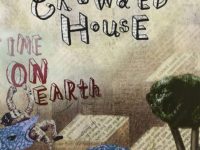This summer’s reunion of those pop perfectionists Crowded House had me back listening to this terrific mid-90s release, which — like the new tour — does not include longtime frontman Neil Finn’s brother Tim.
From its completely realized debut with producer Mitchell Froom to the transformations when Neil and Tim (former leaders of the new wave outfit Split Endz) came and went as partners in songwriting, this New Zealand band never failed to put out an air-tight, listenable record. Still, offerings like 1991’s “Woodface” (which included Tim) were very nearly too precious. This one established itself as a more straight-forward, if ornamented, release — and that made it one you can live with.
First, it’s a moment when Neil seemed to come into his own as a vocalist. His performance on the title track, in particular, was intelligent and unguarded. In fact, on several tunes — notably “Nails in My Feet” and “Distant Sun” — he pushed his voice well beyond what we’d heard before.
Too, there were evocative nods to the band’s South Pacific surroundings, including guest shots by the Waka Huia Choir and a group of Auckland log drummers.
That subtle evolution gives Finn’s simple love songs a heightened reality, and surprising cultural heft, on repeated listenings.
Clearly, Neil has always had an emotive voice (“Don’t Dream It’s Over,” the Endz’ accessible “I Got You”), but this was something else entirely — a baring of soul belying its pop underpinnings.
Pay close attention to a powerfully repeated line in “Nails”: “It brings me relief.” Neil never sang it the same way twice. That nearly approaches the emotional arch of his octave jump in “Sun” (perhaps the best song here) on the line, “no fire where I lit my spark.”
Credit, lastly, American Mark Hart’s incisive guitar — which had a profound influence, even on the generally more expected ballads. (Hart had replaced Tim Finn on “Together Alone” after the previous tour with Crowded House.)
It was intimated at the time that this sound was more in keeping with the group’s in-concert approach. “Together Alone” was actually something new entirely — a welcome roughing up of a perhaps too-smart band, one reacting to both the heavy sounds of the then-new college rock scene but also the equally satisfying seepage of worldly rhythms into mainstream pop.
Paired with Tim Finn’s more conventional “Before and After” CD of the same period (which included two tunes from the “Woodface” sessions), it was a moving new manifesto on what popular music can, even now, aspire to.
- How Deep Cuts on ‘Music From Big Pink’ Underscore the Band’s Triumph - July 31, 2023
- How ‘Islands’ Signaled the Sad End of the Band’s Five-Man Edition - March 15, 2022
- The Band’s ‘Christmas Must Be Tonight’ Remains an Unjustly Overlooked Holiday Classic - December 25, 2016


